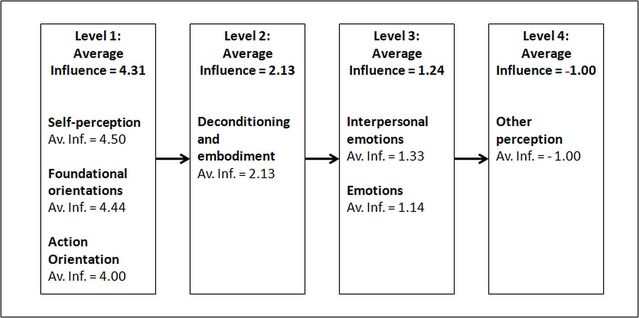Mindfulness
The Experience of Oneness
Understanding the nature of oneness experience using collective intelligence.
Posted October 2, 2020 Reviewed by Jessica Schrader
Research on meditation and mindfulness is flourishing with a particular focus on wellbeing outcomes. However, recent Western accounts of mindfulness depart from Eastern traditions in important ways. For example, one idea that is often ignored in Western mindfulness is the fundamental idea that everything, including the self, is part of the same whole.
This idea of "oneness" is seen in Eastern traditions such as Buddhism, Hinduism, Confucianism, and Taoism. While ideas of oneness do feature as part of Western culture, they generally run counter to more dominant individualistic Western conceptions of a separate self and thus are rarely included as part of mindfulness practice, intervention, and research evaluation (cf. Dambrun et al., 2019). This is somewhat surprising given that oneness has traditionally been considered to be a consequence of mindfulness and a cause of well-being (Ivanhoe et al., 2018).

William James (1902, p. 419) was one of the first psychologists to recognise the importance of oneness experiences:
“In mystic states, we both become one with the Absolute and we become aware of our oneness.”
Similarly, Hood (1975) and Newberg and Waldman (2017) include oneness in their descriptions of mysticism and enlightenment. Oneness has also been characterised as an advanced form of self-transcendence, which Mills et al. (2018) and Yaden et al. (2017) describe as involving dissolved self and self-boundaries.
While there been some recent attention on oneness in the psychology literature, there are no scales specifically designed to measure oneness experiences. Existing scales have limitations such as measuring only beliefs in oneness (Diebels and Leary, 2019; Garfield et al., 2014). Another problem is that measures are not often grounded in qualitative research focused on people’s direct experience of oneness. In a recent study, we sought to understand aspects of oneness experience using a qualitative, collective intelligence (CI) methodology. Based on this study we are now using a questionnaire to test a new oneness scale and we would be very grateful if could consider completing it. We’re very interested in hearing from people who have experience practicing different forms of meditation or mindfulness.
In our collective intelligence (CI) work, a total of 41 meditators attended one of five CI sessions. The CI method allows for the sharing of perspectives and the development of systems thinking models that represent the reasoning of a group (see e.g. Groarke and Hogan, 2016; Hogan et al., 2015).
In our study, participants were each asked to describe five important aspects of oneness self-perceptions (OSPs): “In what ways do you see yourself as oneness, in terms of your feelings and identity, in terms of how you relate to others, and in terms of your values, goals, and actions?”
Reviewing all the ideas generated by their group, participants then selected five OSPs they believed were the most important. The group then mapped out relationships among selected OSPs, focusing specifically on ways in which different OSPs enhance one another in a system of experience.
Results
A total of 377 OSPs were identified across 14 distinct categories of experience, which were then further organised into 7 higher-order themes. The themes and categories can be seen in Figure 1, and they range from fundamental changes in perception, emotion, action, identity, and connection with others.

Five influence structures were also generated across the five CI sessions. For example, as can be seen from Figure 2, one group of experienced meditators considered "a sense of being boundless or infinite" as a fundamental driver of other aspects of oneness experience.

A structural meta-analysis of the models generated across all five CI sessions (see Figure 3) indicated that OSPs focused on self-perception, foundational orientations, and action orientation exerted the greatest influence on other OSPs.

Conclusion
The current study suggests that changes in fundamental aspects of perception, including "boundlessness" and "timelessness"), along with changes in self/identity (e.g. "non-separation") appear to influence the experience of other OSPs. This is consistent with many descriptions of oneness that describe it as a shift in perception (Adyashanti, 2009; Mills et al., 2018), perceptual stance (Krägeloh, 2018), perspective (de Castro, 2017; Schoenberg and Vago, 2019), self-perception (Brown and Engler, 1980; Mills et al., 2018), self-perspective (Hanley et al., 2018), or identity (Paul, 2008), for example, where “awareness is viewing the self rather than the self-being aware of the experience” (de Castro, 2017, p.3).
The experiences to the right of the meta-structure might be "side effects" of these foundational experiences (see e.g. Adyashanti, 2004). The results of the current study are also consistent with the idea that well-being changes may be influenced by oneness perceptual changes, as opposed to the reverse (Blackstone, 2012). Further research using our oneness measure will help to clarify this issue. Again, we would be very grateful if you would consider completing our questionnaire.
References
Featured Paper: Van Lente, E., & Hogan, M. J. (2020). Understanding the Nature of Oneness Experience in Meditators Using Collective Intelligence Methods. Frontiers in Psychology.
Adyashanti (2004). Emptiness Dancing. Boulder: Sounds True.
Adyashanti (2009). The End of Your World: Uncensored Straight Talk on the Nature of Enlightenment. Louisville, CO: Sounds True.
Blackstone, J. (2012). Embodied Nonduality. Available online at: http://undividedjournal.com/?p=536 (accessed March 03, 2020).
Brown, D. P., and Engler, J. (1980). The stages of mindfulness meditation: A validation study. J. Transpers. Psychol. 12, 143–192.
Dambrun, M., Berniard, A., Didelot, T., Chaulet, M., Droit-Volet, S., Corman, M., et al. (2019). Unified Consciousness and the Effect of Body Scan Meditation on Happiness: Alteration of Inner-Body Experience and Feeling of Harmony as Central Processes. Mindfulness (N. Y). 10, 1530–1544. doi:10.1007/s12671-019-01104-y.
de Castro, J. M. (2017). A model of enlightened/mystical/awakened experience. Psycholog. Relig. Spiritual. 9, 34–45. doi:10.1037/rel0000037.
Diebels, K. J., and Leary, M. R. (2019). The psychological implications of believing that everything is one. J. Posit. Psychol. 14, 463–473. doi:10.1080/17439760.2018.1484939.
Garfield, A. M., Drwecki, B. B., Moore, C. F., Kortenkamp, K. V., and Gracz, M. D. (2014). The oneness beliefs scale: Connecting spirituality with pro-environmental behavior. J. Sci. Study Relig. 53, 356–372. doi:10.1111/jssr.12108.
Groarke, J. M., and Hogan, M. J. (2016). Enhancing wellbeing: An emerging model of the adaptive functions of music listening. Psychol. Music 44, 769–791. doi:10.1177/0305735615591844.
Hanley, A. W., Nakamura, Y., and Garland, E. L. (2018). The Nondual Awareness Dimensional Assessment (NADA): New tools to assess nondual traits and states of consciousness occurring within and beyond the context of meditation. Psychol. Assess. 30, 1625–1639. doi:10.1037/pas0000615.
Hogan, M. (2010). Culture of Our Thinking in Relation to Spirituality. Hauppague, NY: Nova Science Publishers, Incorporated.
Hogan, M. J., Dwyer, C. P., Harney, O. M., Noone, C., and Conway, R. J. (2015a). “Metacognitive Skill Development and Applied Systems Science: A Framework of Metacognitive Skills, Self-regulatory Functions and Real-World Applications,” in Metacognition: Fundaments, Applications, and Trends: A Profile of the Current State-Of-The-Art, ed. A. Peña-Ayala (NY, NY: Springer International Publishing), 75–106. doi:10.1007/978-3-319-11062-2_4.
Hood, R. W. (1975). The Construction and Preliminary Validation of a Measure of Reported Mystical Experience. J. Sci. Study Relig. 14, 29–41. doi:10.2307/1384454.
Ivanhoe, P. J., Flanagan, O. J., Harrison, V. S., Sarkissian, H., and Schwitzgebel, E. eds. (2018). The Oneness Hypothesis: Beyond the Boundaries of the Self. New York, NY: Columbia University Press.
James, W. (1985). The varieties of religious experience (Original work published 1902). London, England: Penguin.
Krägeloh, C. U. (2019). Phenomenological Research Fails to Capture the Experience of Nondual Awareness. in Mindfulness (Springer New York LLC), 15–25. doi:10.1007/s12671-018-0995-z.
Mills, P. J., Peterson, C. T., Pung, M. A., Patel, S., Weiss, L., Wilson, K. L., et al. (2018). Change in Sense of Nondual Awareness and Spiritual Awakening in Response to a Multidimensional Well-Being Program. J. Altern. Complement. Med. 24, 343–351. doi:10.1089/acm.2017.0160.
Newberg, A. B., and Waldman, M. R. (2017). How enlightening changes your brain: The new science of transformation. New York, NY: Penguin.
Paul, A. (2008). A grounded theory investigation of awakening/realization in direct/top-down approach: Implications for a psychology of awakening (Doctoral Dissertation). Institute of Transpersonal Psychology.
Schoenberg, P. L. A., and Vago, D. R. (2019). Mapping meditative states and stages with electrophysiology: concepts, classifications, and methods. Curr. Opin. Psychol. 28, 211–217. doi:10.1016/j.copsyc.2019.01.007.
Stace, W. T. (1960). Mysticism and philosophy. Philadelphia, PA: Lippincott.
Warfield, J. N., and Cárdenas, A. R. (1993). A handbook of interactive management. Ames, Iowa: Iowa State University Press.
Yaden, D. B., Haidt, J., Hood, R. W., Vago, D. R., and Newberg, A. B. (2017). The varieties of self-transcendent experience. Rev. Gen. Psychol. 21, 143–160. doi:10


